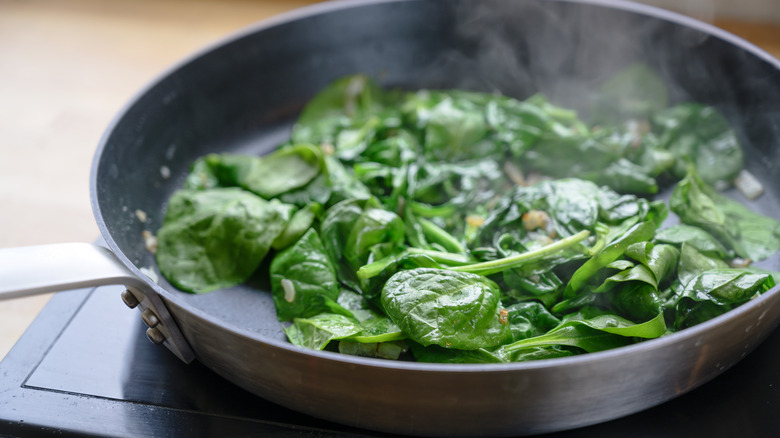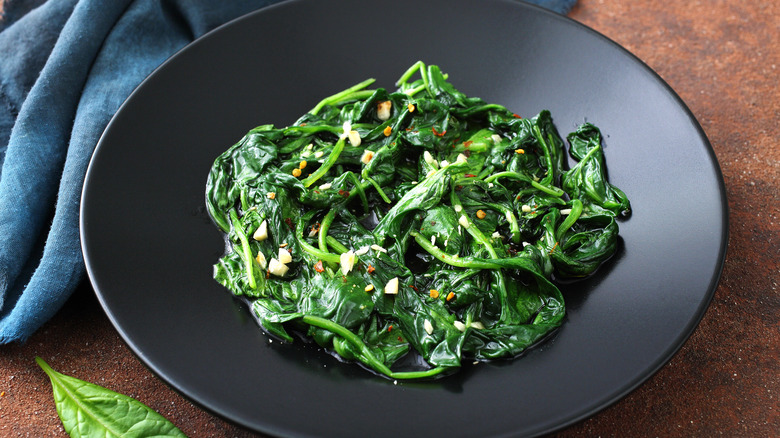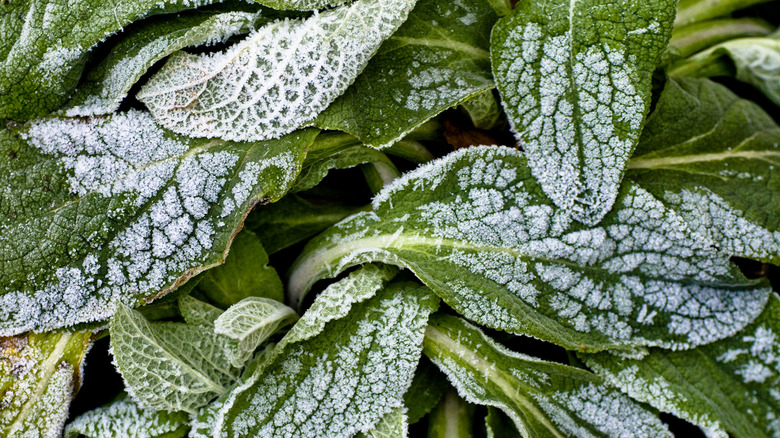Why You Should Be Squeezing The Life Out Of Cooked Spinach
Whether you start with fresh or frozen spinach, this delicate leafy green can be hard to cook just right. It's easy to wind up with water-logged, slimy, and downright unappetizing results. Fortunately, adding a single, easy step to your preparation can make all the difference and reward you with a perfectly tender (and non-watery) result.
This step is as simple as squeezing the excess moisture out of the leaves after cooking them. Your may think to use a paper towel or dish towel, but this method can make a mess and fail at being effective. Instead, for spinach that is still hot, use a potato ricer to gently but efficiently squeeze water out. You can also use a colander or strainer with small-enough holes to keep the spinach leaves from escaping. Just put your spinach in the colander, place a bowl over top (sandwiching the spinach in place), and add some weight to press the moisture out.
Alternatively, you can let the spinach cool, then squeeze it with your bare hands. This method takes a bit more time and requires you to work in smaller batches, but it works just as well as using any of the aforementioned expensive cooking tools. And no need to worry that the spinach will turn to mush — it's the excess moisture you just got rid of that causes the greens to break down into slop.
Cooking methods to prevent soggy spinach
As you can imagine, some cooking methods are better than others when minimizing spinach's soggy tendencies. Boiling is among the worst options, as it not only results in slimy, waterlogged spinach, but also removes some of its nutrients, like vitamin C and folate. Instead, one of the best ways to cook spinach is a process called wilting.
To try it, add spinach to a frying pan with nothing more than a dash of oil, vinegar, and any seasonings you'd like. Set the heat to medium-high to evaporate any moisture that the greens release, but only cook until the leaves start to shrink and turn a darker green. At this point, the leaves should be tender, but not mushy. You may choose add your spinach straight to a dish like a creamy polenta with white beans, but you can also take a moment to squeeze out any remaining water if you want to eat it by itself.
Another method for achieving perfectly tender spinach is by steaming. Without any special kitchen tools, the easiest way to steam spinach is by cooking it in the microwave with a damp paper towel for moisture. Again, cook the spinach only until it's tender, as overcooking will reduce the leaves to a soggy mess. This can take just two minutes if your microwave is set to high power. Give the steamed leaves a light squeeze, and you're good to go.
Frozen vs. fresh spinach: Is one soggier than the other?
You now know a lot about cooking spinach the right way, but you might be wondering if fresh or frozen spinach is better. Sure, choosing frozen spinach means the leaves are already cooked, and you can avoid the dreaded shrinkage that happens when you cook the fresh stuff. What's more, the quick-cook and flash-freeze methods used to produce frozen spinach preserves its nutrients better than most at-home cooking methods. Best of all, frozen spinach is both cheaper and easier to store than fresh spinach.
That being said, frozen spinach often comes at the cost of excess moisture and limp texture. When the veggie is frozen, the water within the leaves expands and causes structural damage. As the spinach thaws out again, all that water escapes, and you're left with a pile of soggy and oversaturated greens, unless you immediately apply heat to evaporate the water. A thorough stove-top cook or even just a quick thaw in the microwave can do the job.
Of course, you can minimize further mushiness by using the squeezing method, but fresh spinach will almost always provide you with a better texture to start with. At the end of the day, however, either option can turn out great with the right preparation steps.



